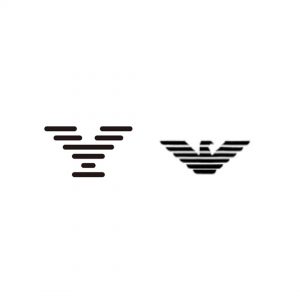On 29 December 2020 Shenzhen City Chongzhen Tecnology Co. Ltd filled an EUTM application for a figurative sign consisting of 6 horizontal black lines, on a white background, forming the shape of the letter “Y” or “V”, for goods and services in Class 9 regarding electronic devices.

However, on 9 April 2021, the company Giorgio Armani SpA filed an opposition on the basis of its earlier figurative EUTM Nº15743891 registered on 6 January 2017 for Classes 9 and 25. The opponent’s trademark is also composed by 6 horizontal black lines, on a white background, forming the image of a bird.
The opposing party argued that the coexistence of both trademarks on the market was incompatible due to the similarity of the signs, as well as the similarity of goods and services marketed in Class 9. Therefore there is a clear likelihood of confusion on the basis of Article 8(1)(b) of the EU Trade Mark Regulation. Furthermore, the Article 8(5) of the mentioned regulation is also invoked by the opponent regarding the reputation of its earlier trade mark. However, the opposition and its subsequent appeal were rejected by the EUIPO, concluding that the overall impression produced by the trade marks was different.
The opponent appealed the EUIPO’s decision to the Court of Justice of the European Union, alleging that the assessment of the similarities and likelihood of confusion had been erroneous, as it had not taken into account that the conflicted signs were both presented in the shape of a “V”. Therefore, both signs were evoking the same image of a stylised bird. The opponent also pointed out that both signs were constituted by the same elements (6 horizontal black lines on a white background with a symmetrical axis).
On the contrary, the EUIPO argued that despite the element shared by the two signs, the global representation of the conflicted trade marks was different. In this sense, the EUIPO argued that the eagle’s head was clearly discernible on the earlier trade mark, and so it was the lower horizontal line on the applicant’s trade mark that suggested the shape of the letter “V”, therefore these elements were clearly distinctive for each sign. The European Office considers that when it comes to minimalist signs even the most subtle difference could produce a very distinguishable overall impression.
The Court of Justice of the European Union found that the signs were composed by the same elements represented in a subtly different form. However, it concluded that since the differences were so ephemeral, a different visual overall impression could not be considered. The Court concluded that the eagle’s head from the earlier trade mark and the lower horizontal line from the applicant’s sign were elements of minor relevance, as both signs will be perceived in a plain form of a “V”. Nevertheless, the fact that consumers retain an imperfect image of the signs means that the visual similarity will be of low degree.
For all the abovementioned, the Court concludes that the Second Board of Appeal erred in failing to make an overall assessment of the likelihood of confusion due to its erroneous perception of the differences between both trade marks. For this reason, the Court annulled the previous decision.
Judgment of the Seventh Chamber of the Court of Justice of the European Union of 27 November 202 in case T-509/23.


 Español
Español Deutsch
Deutsch